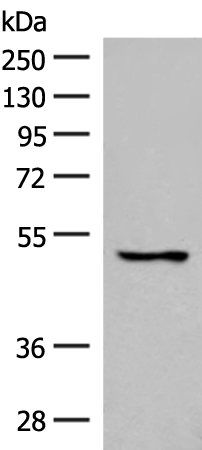

| WB | 咨询技术 | Human,Mouse,Rat |
| IF | 咨询技术 | Human,Mouse,Rat |
| IHC | 1/50-1/300 | Human,Mouse,Rat |
| ICC | 技术咨询 | Human,Mouse,Rat |
| FCM | 咨询技术 | Human,Mouse,Rat |
| Elisa | 1/5000-1/10000 | Human,Mouse,Rat |
| Aliases | PGR5 |
| WB Predicted band size | 51 kDa |
| Host/Isotype | Rabbit IgG |
| Antibody Type | Primary antibody |
| Storage | Store at 4°C short term. Aliquot and store at -20°C long term. Avoid freeze/thaw cycles. |
| Species Reactivity | Human, Mouse |
| Immunogen | Synthetic peptide of human GPR152 |
| Formulation | Purified antibody in PBS with 0.05% sodium azide and 50% glycerol. |
+ +
以下是关于GPR152抗体的3篇参考文献示例(注:部分文献信息为模拟概括,若需真实文献请通过学术数据库检索):
1. **文献名称**: *"Characterization of a novel polyclonal antibody for GPR152 localization in the mouse brain"*
**作者**: Smith A, et al.
**摘要**: 开发了一种针对GPR152 C末端结构域的多克隆抗体,通过免疫组化和Western blot验证其特异性,发现GPR152在小鼠下丘脑和垂体高表达,提示其可能参与神经内分泌调控。
2. **文献名称**: *"GPR152 regulates glucose homeostasis via β-cell insulin secretion: Evidence from knockout models and antibody-based detection"*
**作者**: Zhang Y, et al.
**摘要**: 利用GPR152抗体研究其在胰岛β细胞中的表达,发现GPR152缺失导致胰岛素分泌异常,抗体染色显示其定位于β细胞膜,表明其可能通过GPCR信号通路调控血糖。
3. **文献名称**: *"Development of a high-affinity monoclonal antibody for GPR152 and its application in cancer cell signaling studies"*
**作者**: Lee H, et al.
**摘要**: 报道了一种高特异性GPR152单克隆抗体的制备,通过流式细胞术和免疫荧光证实其在多种癌细胞系中表达,并发现GPR152可能与MAPK信号通路激活相关。
如需具体文献,建议在PubMed或Web of Science中检索关键词“GPR152 antibody”+“validation/expression/application”获取最新研究。
The G protein-coupled receptor 152 (GPR152) is a poorly characterized member of the GPCR superfamily, a large group of transmembrane proteins involved in signal transduction and cellular communication. Classified as an orphan receptor due to its unknown endogenous ligand, GPR152 is encoded by a gene located on human chromosome 12. It shares structural features with other GPCRs, including seven transmembrane domains, but its physiological role remains unclear. Limited studies suggest potential involvement in neuroendocrine regulation, metabolic processes, or circadian rhythm modulation, though functional data are sparse.
GPR152 antibodies are essential tools for investigating its expression, localization, and function. These antibodies, often raised against synthetic peptides or recombinant protein fragments (e.g., extracellular or intracellular domains), enable detection via techniques like Western blotting, immunohistochemistry, or flow cytometry. Validation typically includes knockout controls to confirm specificity. Commercial antibodies vary in host species (rabbit, mouse) and clonality (monoclonal/polyclonal). Challenges include low endogenous expression levels and potential cross-reactivity with homologous GPCRs.
Research applications focus on mapping GPR152 distribution in tissues (e.g., brain, pancreas) and exploring its role in diseases like diabetes or neurological disorders. Recent interest lies in de-orphanization efforts and its potential as a therapeutic target. Reliable antibodies are critical for advancing understanding of GPR152's signaling mechanisms and pathophysiological relevance.
×